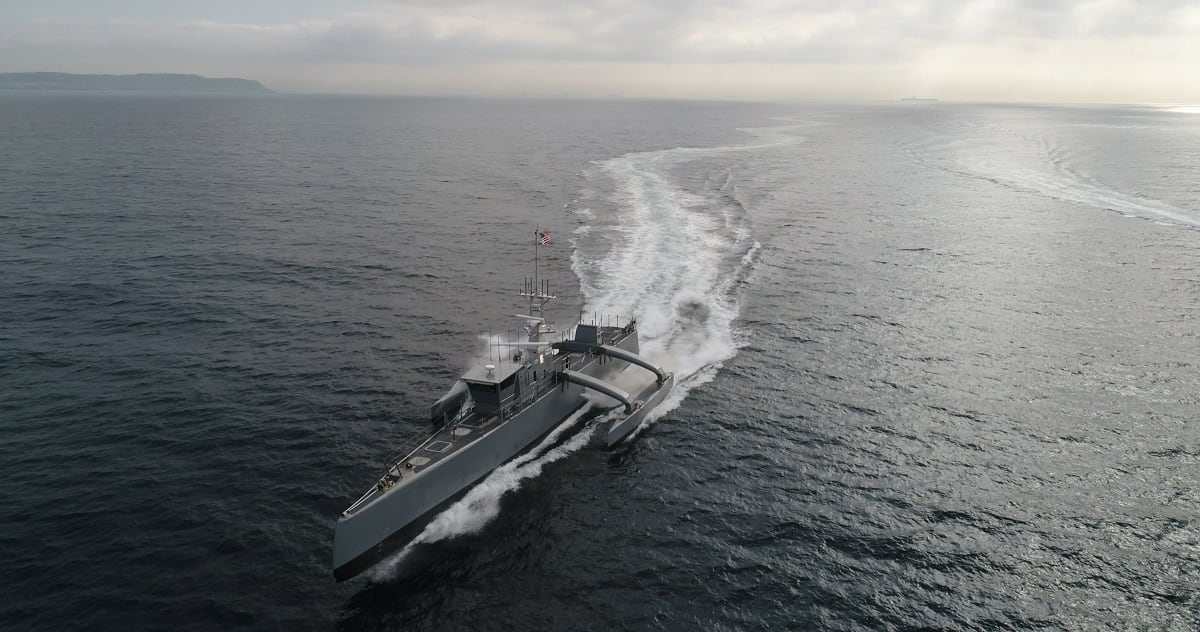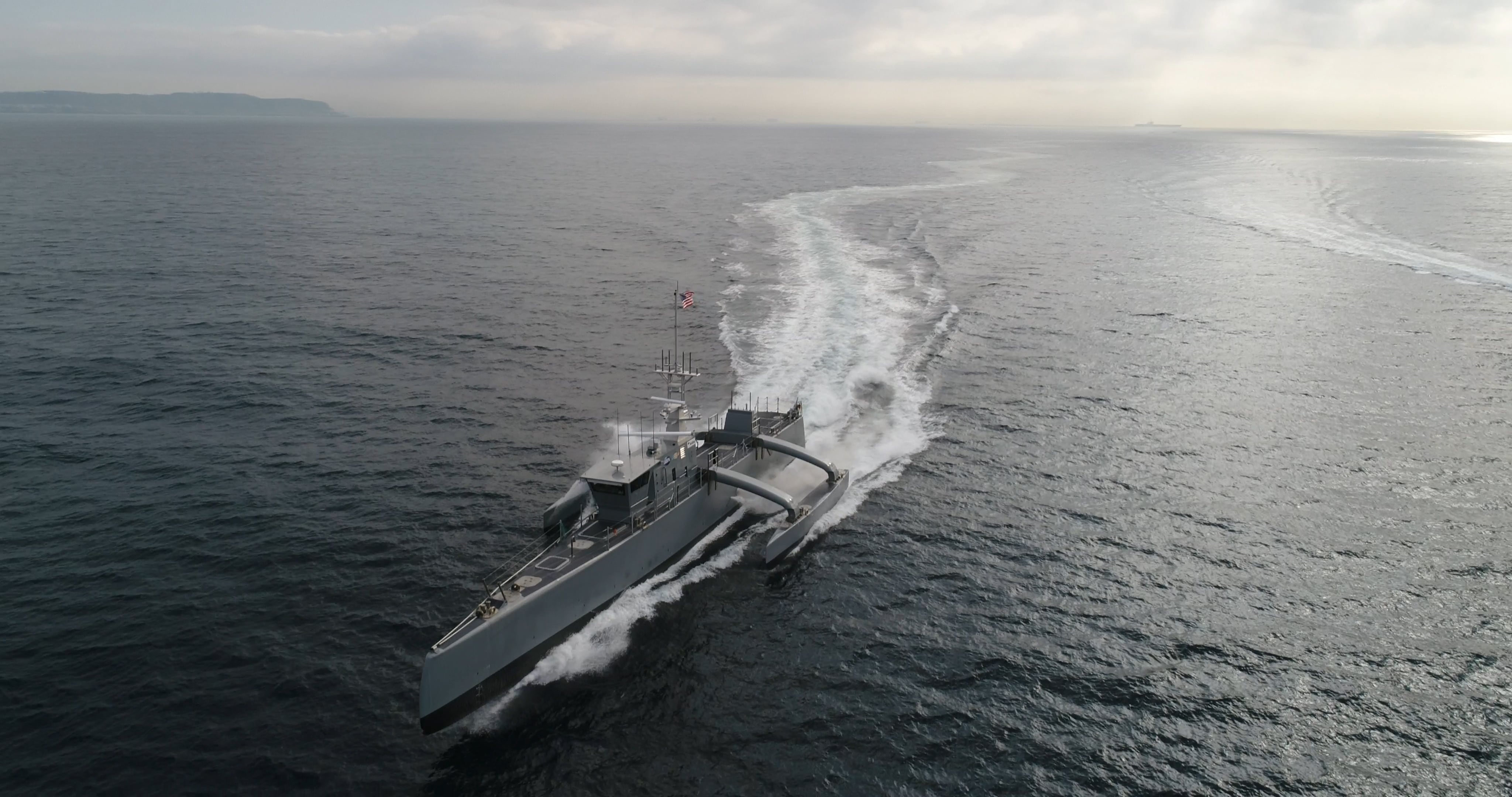WASHINGTON — The U.S. Navy’s top officer has ordered his staff to develop a comprehensive strategy to field unmanned systems in the air, on the water and under the sea over the coming years.
Dubbed “unmanned campaign plan,” it looks to tie together all the disparate programs into a coherent way forward, Chief of Naval Operations Adm. Michael Gilday told Defense News in a July 16 interview.
“We’ve got … a family of unmanned systems we’re working on,” Gilday said. “Undersea we’ve got extra-large, large and medium [unmanned underwater vehicles]; on the surface we have small, medium and large [unmanned surface vessels]; and in the air we have a number of programs.
“What I’ve asked the N9 to do is come to me with a campaign plan that ties all those together with objectives at the end. I’ve got a bunch of horses in the race, but at some point I have to put my money down on the thoroughbred that’s going to take me across the finish line so I can make an investment in a platform I have high confidence in and that I can scale.”
RELATED

Gilday’s drive toward an unmanned campaign plan comes after two consecutive years of congressional criticism that the Navy is forging ahead too quickly on unmanned systems without first having designed or developed critical new technologies and mechanical systems. The criticisms have resulted in marks in legislation that deliberately slows down the development of the systems that both the Navy and the Office of Secretary of Defense have said are necessary to offset a rising China without breaking the bank.
In the interview, Gilday acknowledged the Navy hadn’t adequately mapped out its unmanned future in a way that would inspire confidence.
“What I’ve found is that we didn’t necessarily have the rigor that’s required across a number of programs that would bring those together in a way that’s driven toward objectives with milestones,” Gilday said. “If you took a look at [all the programs], where are there similarities and where are there differences? Where am I making progress in meeting conditions and meeting milestones that we can leverage in other experiments? At what point do I reach a decision point where I drop a program and double down on a program that I can accelerate?”
In the most recent National Defense Authorization Act, currently working its way through Congress, lawmakers appear poised to restrict funding for procurement of any large unmanned surface vessels, or LUSV, until the Navy can certify it has worked out an appropriate hull as well as mechanical and electrical system, and that the design can autonomously operate for 30 consecutive days.

Furthermore, the Navy must demonstrate a reliable operating system and ensure any systems integrated into the platform — sonars, radars, etc. — are likewise functioning and reliable, according the text of the subcommittee’s markup of the fiscal 2021 NDAA, Congress’s annual defense policy bill, which was obtained by Defense News.
In short, the language would mean the Navy could not spend procurement dollars on a large unmanned surface vessel until it has a working model, and it may not try to develop those technologies on the fly.
In a June interview with Defense News, Rep. Joe Courtney, D-Conn., head of the Subcommittee on Seapower and Projection Forces, said the panel supports unmanned system development but doesn’t want the Navy repeat mistakes.
“The message I want people to understand is that we fully support the move toward unmanned, whether that’s on the surface or undersea,” Courtney said. “But we want to make sure that some of the real nuts and bolts issues … are worked out before we start building large unmanned platforms.
“We want to make sure that, again, we don’t end up with situations like LCS [the littoral combat ship] where we’re trying to figure out what the mission is at the same time we’re building them.”
Conceptualize and control
That’s a criticism the CNO hears and is working to address.
Gilday is pushing on two major efforts to get better answers on what the Navy is trying to accomplish with unmanned systems: a concept of operations, and a network to control them with.
“The concept of operations that the fleet is working on right now will be delivered in the fall, and that talks conceptually about how we intend to employ unmanned in distributed maritime operations,” Gilday said, referencing a Navy plan to physically expand its maneuvers to complicate enemy targeting rather than aggregate around an aircraft carrier.
RELATED

But beyond how unmanned tech will fit into a distributed fleet, the Navy is looking at where those systems should be located and how they will be supported. That’s leading the Navy to consider stationing the systems and support elements overseas.
“What would a day-to-day laydown look like of unmanned forward?” Gilday asked. “The Navy has got to be forward: For obvious reasons we don’t want the fight back here; the Navy exists to operate forward. That’s where we need to be in numbers. And with unmanned, if you are not there at the right time, you are irrelevant.
“There also has to be a number of unmanned [systems] forward. I can’t just decide to rally unmanned out of San Diego or in the Pacific northwest at a time when they’ll be too late to need.”
The other big piece of the puzzle is something Gilday has previously referred to as akin to a new “Manhattan Project,” a rapid, well-funded project to field a network that can control all the various unmanned and networked systems, sensors and weapons.
RELATED

And to do that, he’s linking in with the Air Force’s Joint All Domain Command and Control, or JADC2, effort.
“The other piece of this is the Navy Tactical Grid,” Gilday explained. “Coming into the job, the projections for the Navy Tactical Grid was for delivery in about 2035. I knew that was way, way too late.
“So, on a handshake with [Air Force Chief of Staff] Gen. [David] Goldfein, I said: ‘Look, I am all in, and my vision is that the Navy Tactical Grid would be the naval plug into JADC2.' So the Navy Tactical Grid ends up being a very critical element of the unmanned campaign plan because it becomes the main artery to operate those platforms.
“Without it, I have a bunch of unmanned that I shouldn’t be building because I can’t control it very well.”
David B. Larter was the naval warfare reporter for Defense News.







